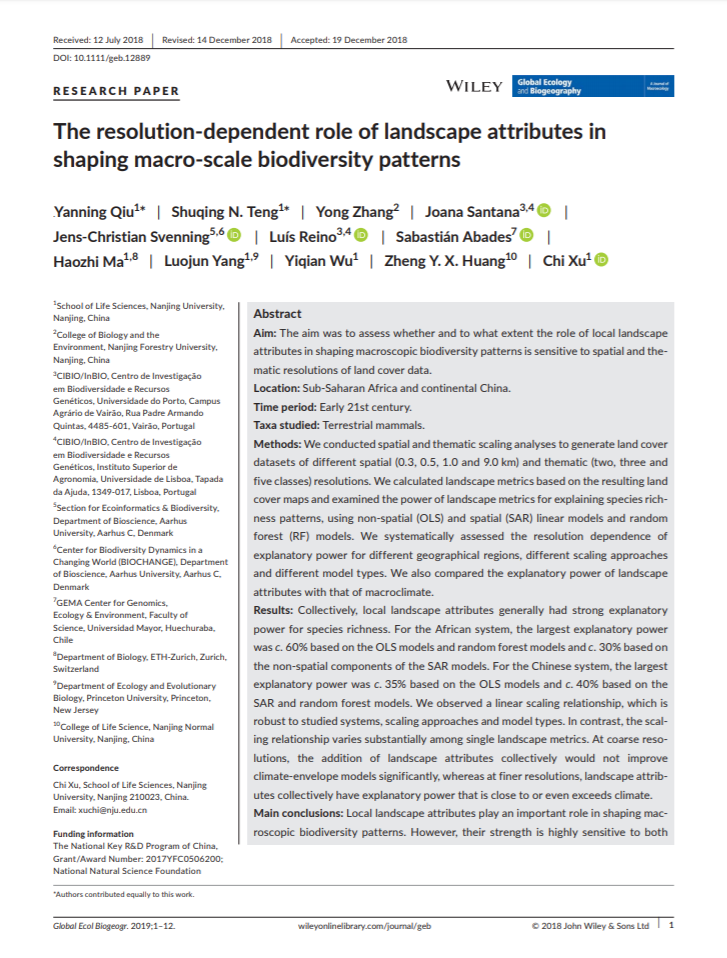The resolution-dependent role of landscape attributes in shaping macro-scale biodiversity patterns

Fecha
2019Autor
Abades, Sabastián [Univ Mayor, Fac Sci, GEMA Ctr Gen Ecol & Environm, Huechuraba, Chile]
Qiu, Yanning; Teng, Shuqing N.; Zhang, Yong; Santana, Joana; Svenning, Jens-Christian; Reino, Luis; Ma, Haozhi; Yang, Luojun; Wu, Yiqian; Huang, Zheng Y. X.; Xu, Chi
Ubicación geográfica
Notas
HERRAMIENTAS
Acceda a títulos restringidos
¿Cómo descargar?Resumen
Aim The aim was to assess whether and to what extent the role of local landscape attributes in shaping macroscopic biodiversity patterns is sensitive to spatial and thematic resolutions of land cover data. Location Sub-Saharan Africa and continental China. Time period Early 21st century. Taxa studied Terrestrial mammals. Methods We conducted spatial and thematic scaling analyses to generate land cover datasets of different spatial (0.3, 0.5, 1.0 and 9.0 km) and thematic (two, three and five classes) resolutions. We calculated landscape metrics based on the resulting land cover maps and examined the power of landscape metrics for explaining species richness patterns, using non-spatial (OLS) and spatial (SAR) linear models and random forest (RF) models. We systematically assessed the resolution dependence of explanatory power for different geographical regions, different scaling approaches and different model types. We also compared the explanatory power of landscape attributes with that of macroclimate. Results Collectively, local landscape attributes generally had strong explanatory power for species richness. For the African system, the largest explanatory power was c. 60% based on the OLS models and random forest models and c. 30% based on the non-spatial components of the SAR models. For the Chinese system, the largest explanatory power was c. 35% based on the OLS models and c. 40% based on the SAR and random forest models. We observed a linear scaling relationship, which is robust to studied systems, scaling approaches and model types. In contrast, the scaling relationship varies substantially among single landscape metrics. At coarse resolutions, the addition of landscape attributes collectively would not improve climate-envelope models significantly, whereas at finer resolutions, landscape attributes collectively have explanatory power that is close to or even exceeds climate. Main conclusions Local landscape attributes play an important role in shaping macroscopic biodiversity patterns. However, their strength is highly sensitive to both spatial and thematic resolutions of land cover data, with stronger explanatory power detected at finer resolutions. Strong sensitivity to spatial and thematic resolutions makes landscape attributes highly plastic determinants, leading to contrasting conclusions if based on greatly different resolutions of land cover data. Scaling analyses are needed to examine such cross-scale effects of macroecological determinants systematically.
URI
https://doi.org/10.1111/geb.12889https://onlinelibrary.wiley.com/doi/abs/10.1111/geb.12889
http://repositorio.umayor.cl/xmlui/handle/sibum/6656
Coleccion/es a la/s que pertenece:
Si usted es autor(a) de este documento y NO desea que su publicación tenga acceso público en este repositorio, por favor complete el formulario aquí.